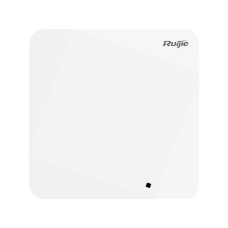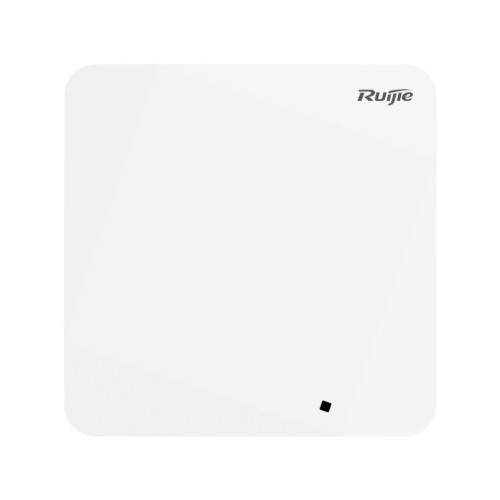RG-AP720-L, Wi-Fi 5 Dual-Radio 1.167 Gbps Indoor AP Best Price In Dubai, UAE.
Availability:
In Stock
Indoor scenarios for higher education, government, general education, finance, and business sectors.
Highlight Features
- Dual Radios, Combined Rate Up to 1.167 Gbps
- Signals Never Drop with Seamless Roaming
- Auto Configuration, Simplified Provisioning, Easy Deployment
- Unified Cloud Management, Intelligent Tuning, Easy O&M
Description
Key Specification
Ruijie Wi-Fi 5 Indoor AP RG-AP720-L





Signals Never Drop with Seamless Roaming
The built-in smart antenna can identify the direction of STAs relative to the AP. With Ruijie's proprietary roaming algorithm, this AP also supports 802.11k/v/r. Intelligent channel planning and accurate wireless positioning enable STAs to associate to the best AP nearby.

Specifications
| Dimensions and Weight |
RG-AP720-L |
| Unit dimensions (W x D x H) |
194 mm x 194 mm x 37 mm (7.64 in x 7.64 in x 1.46 in) |
| Shipping dimensions (W x D x H) |
460 mm x 360 mm x 242 mm (18.11 in x 14.17 in x 9.53 in) |
| Unit weight |
Main unit: 0.42 kg (0.93 lbs) Mounting bracket: 0.07 kg (0.15 lbs) |
| Shipping weight |
0.87 kg (1.92 lbs) |
| Mounting |
Wall/Ceiling-mount (a mounting bracket is delivered with the main unit) |
| Lock option |
Kensington lock and securing latch |
| Wi-Fi Radio |
RG-AP720-L |
| Radio design |
Dual-radio and up to four spatial streams: ● Radio 1: 2.4 GHz, two spatial streams, 2x2 MIMO ● Radio 2: 5 GHz, two spatial streams, 2x2 MU-MIMO |
| Operating frequencies |
Radio 1, 802.11b/g/n: ● 2.400 GHz to 2.4835 GHz, ISM Radio 2, 802.11a/n/ac: ● 5.150 GHz to 5.250 GHz, U-NII-1 ● 5.250 GHz to 5.350 GHz, U-NII-2A ● 5.470 GHz to 5.725 GHz, U-NII-2C ● 5.725 GHz to 5.850 GHz, U-NII-3/ISM Note: Country-specific restrictions apply. |
| Data rates |
Combined peak data rate: 1.167 Gbps 2.4 GHz radio ● Two spatial stream Single User (SU) MIMO for up to 300 Mbps wireless data rate to individual 2SS HT40 802.11n client devices (max.) ● Two spatial stream Single User (SU) MIMO for up to 144.4 Mbps wireless data rate to individual 2SS HT20 802.11n client devices (typical) 5 GHz radio ● Two spatial stream Single User (SU) MIMO for up to 867 Mbps wireless data rate to individual 2SS HT80 802.11ac client devices (typical) |
| Data rate set |
The following 802.11-compliant data rates in Mbps are supported: 2.4 GHz radio ● 802.11b: 1, 2, 5.5, 11 ● 802.11g: 1, 2, 5.5, 6, 9, 11, 12, 18, 24, 36, 48, 54 ● 802.11n: 6.5 to 300 (MCS0 to MCS15, HT20 to HT40) 5 GHz radio ● 802.11a: 6, 9, 12, 18, 24, 36, 48, 54 ● 802.11n: 6.5 to 300 (MCS0 to MCS15, HT20 to HT40) ● 802.11ac: 6.5 to 867 (MCS0 to MCS9, NSS = 1 to 2, VHT20 to VHT80) |
| Packet aggregation |
802.11n/ac: A-MPDU and A-MSDU |
| Antenna type |
Built-in omnidirectional antenna (two 2.4 GHz antennas and two 5 GHz antennas) |
| Max. antenna gain |
4.3 dBi in 2.4 GHz and 5.7 dBi in 5 GHz The downtilt angle for the maximum gain is roughly 30 degrees. With reference to the pattern of each antenna of the MIMO radios, the maximum gain of the effective per-antenna pattern is 3.6 dBi in the 2.4 GHz radio and 4.0 dBi in the 5 GHz radio. |
| Max. transmit power |
2.4 GHz radio: 26 dBm (23 dBm per chain) 5 GHz radio: 26 dBm (23 dBm per chain) Note: The transmit power is limited by local regulatory requirements. |
| Radio technologies |
802.11b: Direct-Sequence Spread-Spectrum (DSSS) 802.11a/g/n/ac: Orthogonal Frequency-Division Multiplexing (OFDM) |
| Modulation types |
802.11b: BPSK, QPSK, CCK 802.11a/g/n: BPSK, QPSK, 16-QAM, 64-QAM 802.11ac: BPSK, QPSK, 16-QAM, 64-QAM, 256-QAM |
The following table lists the radio frequency performance of Wi-Fi including different frequency bands, protocols, and date rates. It is country-specific, and Ruijie Networks reserves the right of interpretation.
| Wi-Fi Radio Frequency Performance |
RG-AP720-L |
||
| Frequency Band and Protocol |
Data Rate |
Max. Transmit Power per Transmit Chain |
Max. Receive Sensitivity per Receive Chain |
| 2.4 GHz, 802.11b |
1 Mbps |
23 dBm |
–91 dBm |
| 2 Mbps |
23 dBm |
–89dBm |
|
| 5.5 Mbps |
23 dBm |
–88 dBm |
|
| 11 Mbps |
23 dBm |
–85 dBm |
|
| 2.4 GHz, 802.11g |
6 Mbps |
23 dBm |
–89 dBm |
| 24 Mbps |
23 dBm |
–80 dBm |
|
| 36 Mbps |
21 dBm |
–76 dBm |
|
| 54 Mbps |
19 dBm |
–70 dBm |
|
| 2.4 GHz, 802.11n (HT20) |
MCS0 |
21 dBm |
–83 dBm |
| MCS7 |
19 dBm |
–65 dBm |
|
| 2.4 GHz, 802.11n (HT40) |
MCS0 |
21 dBm |
–80 dBm |
| MCS7 |
18 dBm |
–62 dBm |
|
| 5 GHz, 802.11a |
6 Mbps |
23 dBm |
–89 dBm |
| 24 Mbps |
23 dBm |
–80 dBm |
|
| 36 Mbps |
21 dBm |
–76 dBm |
|
| 54 Mbps |
19 dBm |
–70 dBm |
|
| 5 GHz, 802.11n (HT20) |
MCS0 |
20 dBm |
–83 dBm |
| MCS7 |
18 dBm |
–65 dBm |
|
| 5 GHz, 802.11n (HT40) |
MCS0 |
19 dBm |
–80 dBm |
| MCS7 |
18 dBm |
–62 dBm |
|
| 5 GHz, 802.11ac (VHT20) |
MCS0 |
20 dBm |
–82 dBm |
| MCS9 |
17 dBm |
–57 dBm |
|
| 5 GHz, 802.11ac (VHT40) |
MCS0 |
19 dBm |
–79 dBm |
| MCS9 |
16 dBm |
–54 dBm |
|
| 5 GHz, 802.11ac (VHT80) |
MCS0 |
19 dBm |
–76 dBm |
| MCS9 |
16 dBm |
–51 dBm |
|
| 5 GHz, 802.11n (HT20) |
MCS0 |
20 dBm |
–83 dBm |
| MCS11 |
18 dBm |
–65 dBm |
|
| 5 GHz, 802.11n (HT40) |
MCS0 |
19 dBm |
–80 dBm |
| MCS11 |
18 dBm |
–62 dBm |
|






Reviews (0)